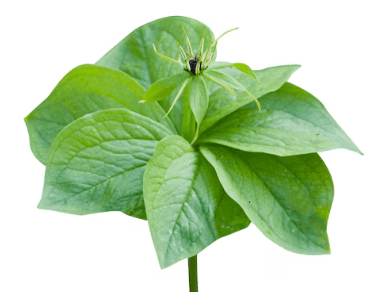
Paris quadrifolia
Latin name: Paris quadrifolia
Short name: Paris
Common name: One-berry | Herb Paris | True Lover’s Knot | Four-leaved Paris | Herb of Enchantment
Primary miasm: Sycotic Secondary miasm(s): Psoric
Kingdom: Plants
Family: Melanthiaceae
- Symptomatology
- Remedy Information
- Differentiation & Application
Paris quadrifolia is a small perennial herb from the Melanthiaceae family, native to temperate regions of Europe and parts of Asia. It bears a single, dark blue-black berry above four leaves in a whorled arrangement. The entire plant, especially the berry, is poisonous in large doses. In homeopathy, it is noted for nerve affections, especially of the spine and eyes, with peculiar sensations of enlargement, numbness, and tingling.
Rarely used in herbalism due to toxicity. Historically associated with folk medicine and ritualistic uses; once regarded as a protective talisman.
Proven by Hahnemann and developed in the 19th century through clinical experience; symptoms expanded by Hering, Clarke, and Allen
- Spinal cord and nerves – especially cervical spine and brachial plexus
- Eyes – strain, pressure, heaviness, diplopia
- Neck and shoulders – stiffness, numbness, electric shocks
- Sensorium – confusion, vertigo, disconnected sensation
- Upper limbs – paraesthesia, trembling, sense of elongation
- Larynx and chest – oppression, pressure, sensitivity
- Muscles – over-excitation and fatigue, as if overused
- Rest
- Lying down
- Warmth
- After sleep (slightly)
- Pressure on the cervical spine
- Slight motion
- Exertion
- Eye strain
- Writing or reading
- Cold air or draft
- Lifting the arms
- Mental concentration
Nervous exhaustion with tingling, heaviness, and peculiar sense of enlargement of body parts. Sensory disturbances predominate: formication, stiffness, coldness. Worse from slight motion, overuse of eyes, or writing. Better from pressure and rest. Suited to persons worn out from study, overuse of eyes, or spinal irritation.
- Complementary: Gelsemium, Kali phos
- Antidotes: Camphora, Nux vomica
- Follows well: Arnica (after trauma), Bryonia
- Precedes well: Calcarea phos in spinal cases
Paris quadrifolia reflects a delicate balance between overuse and sensory breakdown. The individual experiences the world as if from a fatigued, overstimulated nervous system—every joint aches, every nerve tingles, and perception itself becomes distorted. The key theme is nervous overstrain, especially from eye or neck use, producing a state of stiffened awareness, enlarged sensation, and exaggerated fatigue. The mind is dulled while the body twitches. It suits fragile, sensitive constitutions prone to collapse under mental or sensory strain.
- Excellent for neck and shoulder pain in office workers and writers
- Useful in cervical spondylosis with radiating arm pain
- Indicated in eye strain headaches, especially in students
- Suits patients who complain of numbness and tingling but show little on examination
- Valuable in spinal neuralgias with buzzing, crawling sensations
Mind
- Delusion: body is enlarged
- Memory weak
- Mental exertion aggravates
Head
- Sensation: scalp pulled tight
- Heaviness of head
- Vertex pressure
Eyes
- Eye protrusion, sensation of
- Pain behind eyes
- Letters run together while reading
Back
- Pain cervical spine
- Stiffness of neck
- Numbness spine
Extremities
- Heaviness of arms
- Tingling fingers
- Limbs feel too long
Generalities
- Worse from slight motion
- Better from pressure
- Formication
- Samuel Hahnemann – Materia Medica Pura: Provided primary proving data, including tingling, head pressure, and neck pain
- C. Hering – Guiding Symptoms: Described peculiar enlargement sensations, scalp tightness, and spinal affections
- J.H. Clarke – Dictionary of Practical Materia Medica: Detailed eye symptoms, cervical pain, and mental dullness
- Allen – Encyclopaedia of Pure Materia Medica: Documented full proving symptoms with rich physical detail
- Boericke – Pocket Manual of Homoeopathic Materia Medica: Offered clinical uses and keynote modalities, especially neck pain and eye strain
